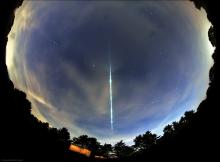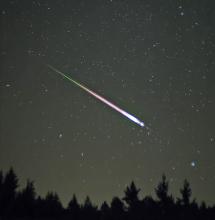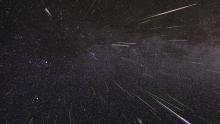Listen to today's episode of StarDate on the web the same day it airs in high-quality streaming audio without any extra ads or announcements. Choose a $8 one-month pass, or listen every day for a year for just $30.
You are here
Leonid Meteors
A minor dust storm will sweep into Earth’s upper atmosphere the next few nights. It’ll produce a smattering of meteors. But a much brighter light source — the Moon — will overpower the show. Only the brightest of the “shooting stars” will shine through the moonglow.
The Leonid shower takes place every November, as Earth crosses the path of Comet Tempel-Tuttle. The comet sheds small bits of dirt and rock as it orbits the Sun. These grains of material spread out along the orbit, forming a thin cloud.
As Earth plows through the cloud, bits of the debris plunge into the atmosphere at high speeds. They quickly vaporize — forming the glowing streaks of light known as meteors.
The Leonids are expected to be at their best before dawn on Monday. As many as a score of meteors might punctuate the sky every hour. With the Moon around, though, you probably won’t see many of them.
But you don’t have to wait for a shower to see meteors. They streak across the sky every night of the year. A few stragglers from the Leonids, for example, are visible for a week or two before and after the shower’s peak.
Other meteors aren’t related to any shower at all. Tiny bits of debris from asteroids and comets are scattered throughout the solar system. Earth sweeps up some of these grains every night.
The main thing you need to enjoy them is a dark sky. Find a moonless night, get away from city lights, then look up and enjoy the fireworks — all year long.
Script by Damond Benningfield






